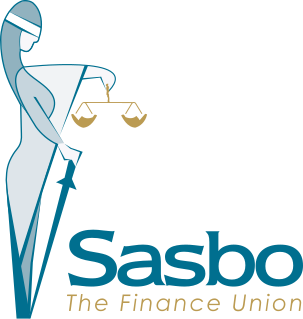Related Research Articles

SASBO – The Finance Union is a trade union in South Africa. It was founded in 1916 and has a membership of 70,000.
Die Spoorbond was an Afrikaner railway trade-union formed in 1934 by H. J. Klopper, founder of the Afrikaner Broederbond, which advocated a policy of replacing all black railway-workers with Afrikaners. It rejected strikes and called instead for loyal service to the South African Railways and Harbours Administration (SARHA). The union had a membership of some 16,000 in the 1930s, considerably more than that of its rival, the National Union of Railway and Harbour Servants, which was forced to dissolve in 1937.
The South African Congress of Trade Unions (SACTU) was a national trade union federation in South Africa.
The Trade Union Council of South Africa (TUCSA) was national trade union federation in South Africa.
The Amalgamated Engineering Union of South Africa (AEU) was a trade union representing white manufacturing workers in South Africa.
The Garment Workers' Union of the Western Province (GWU-WP) was a trade union representing workers in the clothing industry in the Western Cape Province of South Africa.
The South African Boilermakers', Iron and Steel Workers', Shipbuilders' and Welders' Society (SABS) was a trade union representing metalworkers and shipbuilders in South Africa.
The South African Confederation of Labour (SACOL) was a national trade union federation of white workers in South Africa.
The Federation of Free African Trade Unions of South Africa (FOFATUSA) was a national trade union federation for unions representing black workers in South Africa.
The National Union of Furniture and Allied Workers (NUFAW) is a trade union representing workers in the furniture industry in South Africa.
The Salaried Staff Association (SALSTAFF) was a trade union representing railway workers in South Africa.
The Urban Training Project (UTP) was an initiative to encourage black workers in South Africa to form new trade unions.
The South African Trades and Labour Council (SAT&LC) was a national trade union federation in South Africa.
The South African Federation of Trade Unions (SAFTU) was a national trade union federation of workers representing workers in South Africa.
The Federal Consultative Council of South African Railways and Harbours Staff Associations (FCC) was a national trade union federation bringing together unions representing white railway workers in South Africa.
The South African Reduction Workers' Association (SARWA) was a trade union representing officials involved in processing mining ores in South Africa.
The South African Engine Drivers' and Firemen's Association (SAEDFA) was a trade union representing people involved in operating engines in South Africa.
The Engineering Industrial Workers' Union (EIWU) was a trade union representing engineering workers in South Africa.
The South African Railways and Harbours Employees' Union (SAR&HEU) was a trade union representing lower-paid white workers on the railways in South Africa.
The Motor Industry Employees' Union was a trade union representing workers involved in vehicle building in South Africa.
References
- ↑ Gitsham, Ernest; Trembath, James H. (1926). A first account of labour organisation in South Africa (PDF). Durban: E. P. & Commercial Printing. Retrieved 11 April 2021.
- ↑ Wirtz, W. Willard (1966). Directory of Labor Organizations: Africa. Washington DC: Bureau of International Labor Affairs. pp. 39.1–39.28.
- 1 2 Miller, Shirley (1982). Trade Unions in South Africa 1970-1980: a directory and statistics. Cape Town: Southern Africa Labour and Development Research Unit. ISBN 0799204692.
- ↑ Davies, Robert H.; O'Meara, Dan; Dlamini, Sipho (1988). The Struggle for South Africa. Zed Books. ISBN 9780862327637.
- ↑ Von Holdt, Karl (May 1993). "In the number 2 spot" (PDF). South African Labour Journal. 17 (3). Retrieved 25 March 2021.
- ↑ "FEDUSA: Working for the nation" (PDF). South African History Online. Retrieved 25 March 2021.
- ↑ "South Africa". Africa Research Bulletin. 35. 1998.
- ↑ "UNTU History". UNTU. Retrieved 1 April 2021.